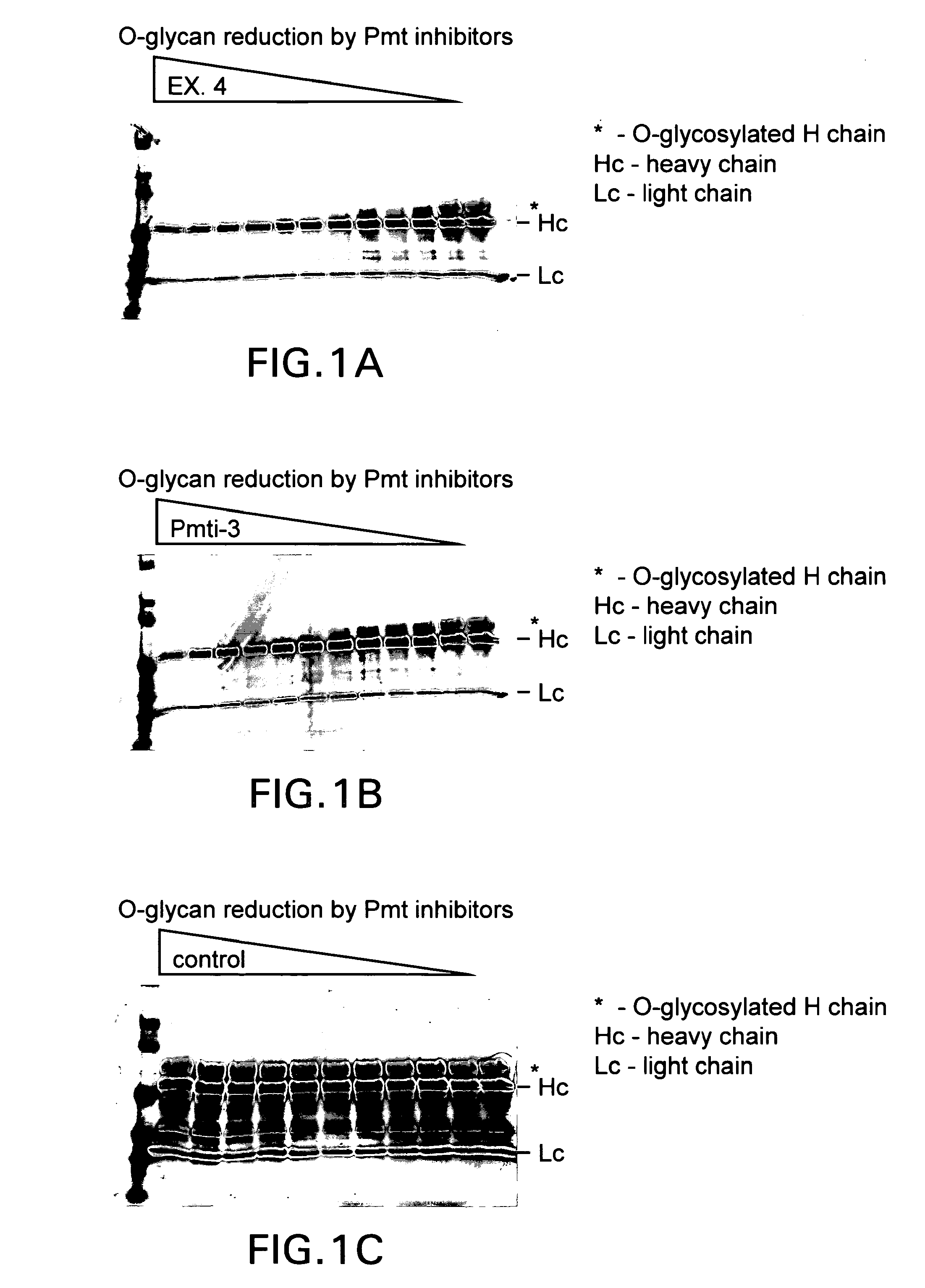Efficient production of heterologous proteins using mannosyl transferase inhibitors
a technology of mannosyl transferase and heterologous proteins, which is applied in the field of efficient production of heterologous proteins using mannosyl transferase inhibitors, can solve the problems of low volumetric titers, heterogeneous glycoform populations produced by the process of producing proteins in mammalian cells, and requires both ongoing viral containment and significant time to generate stable cell lines
- Summary
- Abstract
- Description
- Claims
- Application Information
AI Technical Summary
Problems solved by technology
Method used
Image
Examples
example 1
[0045]
[0046]To a solution of 1-1 (5.90 g, 25 mmol) in THF (200 mL) was added NaH (2.0 g, 50 mmole) portionwise. The resulting mixture was stirred at 0° C. for half an hour. Then NBS (4.86 g, 27.5 mmol) was added into and stirred for 15 minutes. The white solid was filtered and the filtration was concentrated to give a residue, which was dissolved in CHCl3 and dried over Na2SO4. The solvent was evaporated to give 1-2 (5 g, yield 63%), which was used for next step without further purification.
[0047]To a solution of 1-2 (1.8 g, 6 mmol) and 1-3 (1.3 g, 5 mmol) in dried DMF (5 mL) was added NaH (2.4 g g, 10 mmol) and then stirred at room temperature overnight. The resulting mixture was partitioned between water and EtOA. The combined organic layer were washed with brine, dried over sodium sulfate and concentrated. The residue was purified by prep-TLC to give 1-4 (800 mg, yield 40%). 1H-NMR (400 MHz, CDCl3) δ 9.66 (s, 1H), 7.74˜7.71 (m, 2H), 7.4˜7.46 (m, 1H), 7.37˜7.33 (m, 5H), 7.20 (d, J...
example 2
[0054]
[0055]To a solution of compound 2-1 (150 mg, 0.58 mmol, 1.0 eq), compound 2-2 (214 mg, 0.87 mmol, 1.5 eq) in DMF (10 mL) was added Cs2CO3 (161 mg, 0.49 mmol, 0.85 eq). The mixture was then stirred at room temperature overnight and then heated to 80° C. for 1.5 hrs. The resulting mixture was then partitioned between H2O and EtOAc. The combined organic layers were washed with brine and dried over Na2SO4, concentrated and purified by prep-TLC to give 2-3 (122 mg, yield 49.4%).
[0056]A mixture of compound 2-3 (122 mg, 0.29 mmol, 1.0 eq), 2-4 (57 mg, 0.30 mmol, 1.05 eq) and NH4OAc (223 mg, 2.90 mmol, 10.0 eq) in toluene (15 mL) was heated under nitrogen to reflux for about 3 h. The resulting mixture was treated by 10% HCl acid to pH=4-5, and then partitioned between H2O and EtOAc. The combined organic layers were washed with brine and dried over Na2SO4, concentrated and purified by prep-TLC to give EXAMPLE 2 (52 mg, yield 29.9%). 1H-NMR (400 MHz, MeOD) δ 7.41-7.47 (m, 3H), 7.19-7.35...
example 3
[0057]
[0058]To a solution of 3-1 (1 g, 6.37 mmol) in dry THF (20 mL) was added BuLi (3 mL, 7.68 mmol) dropwise at −70° C. and then the mixture was stirred for 30 min at room temperature. After cooling to −70° C. again, a solution of cyclohexanecarbaldehyde (0.72 g, 6.43 mmol) in dry THF (5 mL) was added dropwise. After stirring for 30 min, saturated aqueous NH4Cl was added into the mixture and the resulting mixture was extracted with EtOAc. The organic layers were combined and dried over Na2SO4, concentrated to give 3-2 (1.52 g, 14.3%) as a crude oil.
[0059]To the mixture of 3-2 (600 mg, 3.1 mmol) in dry DCM (15 mL) was added SOCl2 (2 mL) dropwise at 0° C. Then the resulting mixture was stirred for 2 h at room temperature. The mixture was concentrated under reduced pressure and then diluted with EtOAc. The organic layer was washed with saturated aqueous NaHCO3, brine, dried over Na2SO4, and then concentrated to give 3-3 (500 mg, crude).
[0060]To a solution of 3-3 (450 mg, crude) and 3...
PUM
| Property | Measurement | Unit |
|---|---|---|
| temperature | aaaaa | aaaaa |
| temperature | aaaaa | aaaaa |
| temperature | aaaaa | aaaaa |
Abstract
Description
Claims
Application Information
 Login to view more
Login to view more - R&D Engineer
- R&D Manager
- IP Professional
- Industry Leading Data Capabilities
- Powerful AI technology
- Patent DNA Extraction
Browse by: Latest US Patents, China's latest patents, Technical Efficacy Thesaurus, Application Domain, Technology Topic.
© 2024 PatSnap. All rights reserved.Legal|Privacy policy|Modern Slavery Act Transparency Statement|Sitemap



